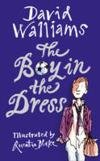The boy in the dress by David Walliams

Harper Collins, 2008.
(Age 9+) I wasn't quite sure what to expect when I started The Boy
in the
Dress
- it's hard to approach a book by half of Little Britain in a
completely objective state of mind.
Walliams' style is reminiscent of Roald Dahl, and I don't think it's
just Quentin Blake's wonderful illustrations that made me feel this.
Walliams has a habit of addressing his readers directly and his writing
is straightforward, unaffected and humorous, while still managing to
convey a depth of feeling that tugs at the heart strings.
Dennis is an ordinary boy who loves football. He lives with his Dad and
older brother and there is a gaping hole in all their lives since the
departure of Mum. Dennis also has an interest in fashion and keeps a
copy of Vogue under his mattress. He meets glamorous Lisa, who
befriends him and encourages him to dress up in some of the gorgeous
frocks she has created. One thing leads to another and before we know
it Dennis finds himself wearing a dress to school and posing as Denise,
Lisa's French exchange friend.
Walliams makes some very interesting observations on the nature of
identity and tradition. He does not comment on Dennis' love of dresses,
and much emphasis is placed on Dennis' role as star striker for the
football team. There is certainly nothing effeminate about Dennis.
Dennis's friend Darvesh is supportive and takes it in his stride when
he discovers his best mate has a penchant for dresses. Indeed Walliams
is careful not to describe Dennis as 'dressing as a girl' but simply as
'wearing dresses'. These are all interesting pointers for discussion
with young readers. After all what does dressing as a girl mean? Women
can wear trousers, so why don't men wear dresses? There are some lovely
touches of humour - Raj the owner of the corner shop fights Dennis'
corner in an unusual way and the cup final football match is an
absolute joy.
The main sticking point will be to get boys to read this book. OK so
there is a (small) picture of a football on the front cover, but that
is accompanied by a large title that many boys in my school will find
impossible to overcome. I can predict that the copy in the school
library will be borrowed by the girls and shunned by boys. Sadly street
cred is everything, even in primary school and it's a shame because the
boys will be missing out on an entertaining, thought provoking read.
One way around this would be to read it aloud. It is perfect for year
5s and 6s and I can guarantee it will raise some laughs and even more
importantly plenty of discussion.
Claire Larson